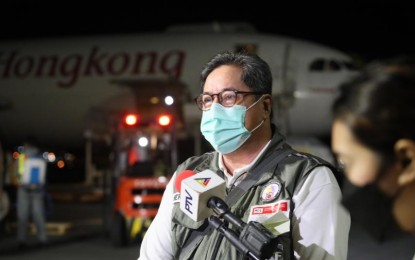[7.3] DOH, 올해 더 짧은 TB 치료 시행
컨텐츠 정보
- 21,200 조회
본문
마닐라 – 보건부(DOH)는 올해 3분기까지 결핵(TB)에 대한 단기 치료 계획을 시행할 계획입니다.
"Teodoro Herbosa" 보건부 장관은 치료가 이전에는 9개월에서 12개월의 치료를 받아야 했던 규칙적인 약물 감수성 결핵을 앓고 있는 개인을 위한 4개월 요법이 될 것이라고 말했습니다.
“WHO[세계보건기구]는 우리에게 4개월 요법을 채택할 것을 권장했는데, 이는 특정 약물 목록에 대해 2개월, 다른 약물 세트에 대해 또 다른 2개월입니다. 이것은 일반적인 약물에 민감한 결핵을위한 것입니다.”라고 그는 월요일 미디어 포럼에서 말했습니다.
그러나 약제내성결핵 환자는 6개월간 치료를 받아야 한다.
결핵 및 HIV 담당관으로 임명된 "Dr. Kezia Lorraine Rosario"는 이러한 새로운 지침을 통해 치료 과정을 거치는 환자가 섭취 기간을 단축하여 "따라서 치료에서 탈락하는 일이 줄어들 것"이라고 말했습니다.
"성인에게 적합한 것은 각각 2개월입니다. 이들은 isoniazid, rifampicin, pyrazinamide 및 ethambutol입니다."라고 그녀는 말했습니다.
"이소니아지드, 리팜피신, 목시플록사신 및 피라진아미드라는 두 가지 약물 세트의 조합인 12세 미만의 어린이."
치료를 위한 새로운 약물 세트와 별도로 DOH는 사례 찾기를 위한 새로운 기술을 통합할 것입니다.
“'Yung GeneXpert ginamit din natin ito(우리가 사용한 GeneXpert)는 Covid 동안에 사용되었습니다. 사실 코비드를 빨리 검출하기 위해 다른 카트리지를 사용했는데 필리핀에 가져왔을 때 글로벌 펀드가 결핵을 검출하기 때문에 가래를 넣을 수 있는 카트리지가 있고 다제내성균을 확인합니다. 결핵은 유전적이기 때문입니다.”라고 "Herbosa"는 말했습니다.
그는 또한 많은 새로운 활동성 결핵 사례가 PLHIV에 속하기 때문에 특히 HIV(PLHIV)에 걸린 사람들을 위해 TB 감지를 위한 측면 흐름 테스트의 추가 파일럿 구현이 있을 것이라고 밝혔습니다.
그는 "AI가 판독할 수 있는 방사선 사진으로 결핵 검출에 인공지능을 사용할 것"이라며 "이는 방사선 사진을 보면 기계가 이미 결핵의 유무를 진단하는 것"이라고 덧붙였다.
모든 결핵 사례를 확실히 알기 위해 Herbosa는 DOH가 레지스트리에 업로드하기 위한 맞춤형 데이터의 실시간 캡처 및 공유를 지원하는 연결 소프트웨어를 사용할 것이라고 말했습니다.
동일한 가정에서 비디오 관찰 치료 및 재발 방지 결핵 예방 치료를 위한 디지털 준수 도구도 구현될 것이라고 Herbosa는 덧붙였습니다.
2022년 WHO 세계 결핵 보고서에 따르면 필리핀은 추정 세계 결핵 사례의 2/3를 차지하는 8개국 중 하나입니다.
또한 인근 인도네시아, 미얀마, 인도와 함께 결핵 사망자 추정 증가의 대부분을 차지하는 국가 중 하나입니다.
2021년 코비드-19 관련 제한으로 인해 결핵 사례 통지가 전 세계적으로 감소한 가장 큰 기여 국가 중 3위를 차지했습니다. 통지는 2020년에 37%, 2021년에는 21% 감소했습니다.
2021년에 이 나라는 발병률이 100,000명당 650명으로 보고되어 2020년 100,000명당 533명보다 높습니다. 가장 높은 사례 통지율은 수도권, 지역 4-A(Calabarzon) 및 Western Visayas였습니다.
DOH는 2021년 사례 찾기 캠페인을 다시 시작했습니다. 2022년 부분 데이터에 따르면 2019년 409,200건보다 높은 433,746건의 사례가 통보되었습니다.
이전에 대통령 "Ferdinand R. Marcos Jr." 는 국가 및 지방 정부, 학계, 사회 및 개발 파트너, 민간 부문 및 실무자가 전적으로 참여하는 사회 전체적 접근 방식을 사용하여 국가의 결핵 상황을 해결하도록 Herbosa에 지시했습니다. (PNA)
This is the Original Article efrom PNA NEWS
[7.3] DOH to implement shorter TB treatment this year
MANILA – The Department of Health (DOH) is planning to implement a shorter treatment scheme for tuberculosis (TB) by the third quarter of this year.
Health Secretary "Teodoro Herbosa" said the treatment would be a four-month therapy for individuals suffering regular drug-susceptible TB who previously must go through nine to 12 months of treatment.
“The WHO [World Health Organization] has recommended us to adopt the four months treatment for regimen, which is two months for a certain list of drugs and another two months for a different set of drugs. This is for the regular drug-susceptible tuberculosis,” he said in a media forum on Monday.
However, individuals with drug-resistant tuberculosis would have to undergo six months of treatment.
Appointed Action Officer for TB and HIV "Dr. Kezia Lorraine Rosario" said these new guidelines ensure that patients undergoing the treatment course would have a shorter span of intake “therefore falling out of the treatment will be lessened”.
“The one that is suitable for the adults, that’s two months each, these are the isoniazid, rifampicin, pyrazinamide and ethambutol,” she said.
“Children until 12 years old that would be a combination of two sets of drugs which is the isoniazid, rifampicin, moxifloxacin, and pyrazinamide.”
Apart from a new set of drugs for treatment, the DOH would be incorporating new technologies for case finding.
“’Yung GeneXpert ginamit din natin ito (The GeneXpert which we used) during Covid. In fact, we used a different cartridge to detect Covid quickly but when it was brought to the Philippines, it is for the Global Fund to detect TB, so it has a cartridge where sputum can be put and then we identify the multiple drug-resistant TB because it is genetic,” "Herbosa" said.
He disclosed there would also be a supplemental pilot implementation of a lateral flow test for TB detection, especially for people living with HIV (PLHIV) as many of the new active TB cases are among the PLHIV.
“We will use artificial intelligence in TB detection by radiographs that can be read by AI, when the radiograph is seen, the machine already diagnoses the presence or absence of TB,” he added.
To ensure all TB cases are known, Herbosa said the DOH would use a connectivity software to support real-time capture and sharing of customized data for uploading to the registry.
Digital adherence tools for video-observed treatment and TB preventive treatments against recurrence in the same household would also be implemented, Herbosa added.
Based on the 2022 WHO Global TB Report, the Philippines is one of the eight countries accounting for two-thirds of the estimated global TB cases.
It is also one of the countries that contribute to most of the estimated increase in TB deaths, along with neighboring Indonesia, Myanmar, and India.
It ranked third among the top contributing countries to the global drop in TB case notifications due to Covid-19-related restrictions in 2021. Its notifications decreased by 37 percent in 2020 and 21 percent in 2021.
In 2021, the country reported an incidence rate of 650 per 100,000 which is higher than the 533 per 100,000 in 2020. The highest case notification rates were in the National Capital Region, Region 4-A (Calabarzon), and Western Visayas.
The DOH restarted its case-finding campaign in 2021. Partial data for 2022 showed that 433,746 cases were notified which is higher than the 409,200 cases for 2019.
Earlier, President "Ferdinand R. Marcos Jr." instructed Herbosa to address the country’s TB situation using a whole-of-society approach with the full participation of national and local governments, academe, societies and development partners, and the private sector and practitioners. (PNA)
관련자료
-
이전
-
다음


